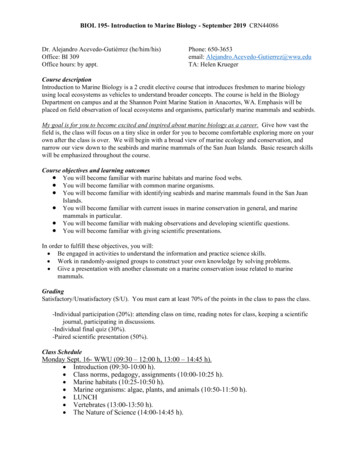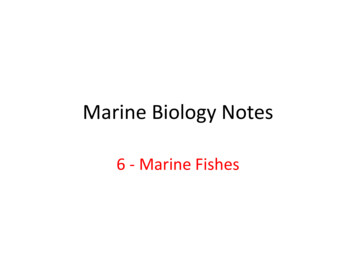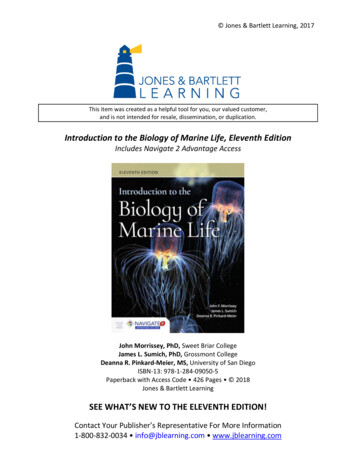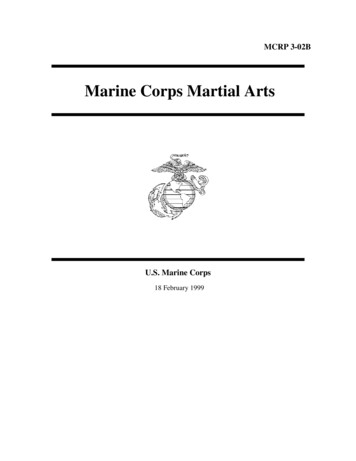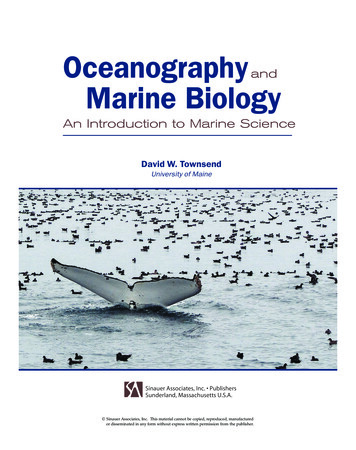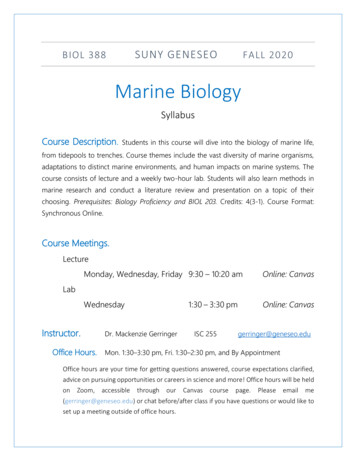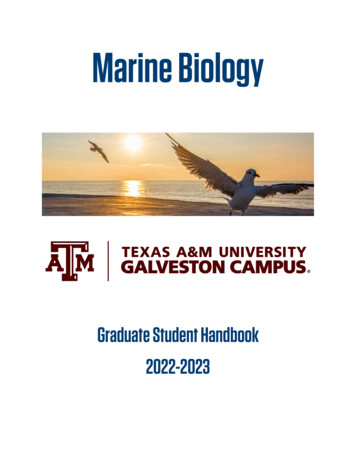
Transcription
Marine BiologyGraduate Student Handbook2022-2023
ContentsIntroduction . 3Admission to the Marine Biology M.S. and Ph.D. Programs . 3Application Deadlines . 6Financial Support . 7One-Year MARB Awards . 7Two-Year Competitive Graduate Student Fellowships . 7Teaching Assistantships . 7Research Assistantships . 7Loans and Scholarships . 8Fellowship and Assistantship Compensation . 8Texas 99 Hour Rule . 8Fulfilling MARB M.S. and Ph.D. Graduate Degree Requirements. 8Core Courses . 10Student Advisory Committee . 10Degree Plan . 12Annual Progress Report . 14Registration Guidelines . 14Thesis/Dissertation Research Proposal . 14Doctoral Preliminary Exams . 15Final Examinations . 15Thesis/Dissertation . 16Non-Thesis Professional Paper . 17Final Approval of Proposals, Theses, and Dissertations . 17Graduation. 18Deadlines . 18Registration and Block Removal . 19Important Contacts. 19Get Connected . 192
IntroductionThis document has been developed for the guidance of faculty members andgraduate students associated with the Marine Biology Graduate Program (MARB) atthe Texas A&M University at Galveston (TAMUG) campus. For prospective students,it contains a brief overview of the program and instructions for applying foradmission and selecting an advisor. For admitted students, it contains informationabout the requirements for successfully completing the degree, the course of study,selecting a graduate committee, preliminary exams/admission to degree candidacy(Ph.D. students), the defense, and the final oral examination. Students associatedwith the M.S. and Ph.D. in the MARB graduate program at TAMUG are required tofollow these departmental and university guidelines and procedures.The faculty in the Department of Marine Biology have developed an excitingcurriculum of graduate classes, but students can also choose courses offered byother TAMUG departments or on the main campus, especially if offered with adistance education (DE) option. Please note that the MARB is not a DE program.Therefore, no student can have more than 50% of their hours coded as DE.The goal of the graduate program is to attract high-quality students interested inone or a combination of the subdisciplines of marine biology who wish to pursuecareers in higher education, government, or private industry. The principalstrengths of this marine biology program lie in the international recognition,scholarly productivity, and extramural funding of its diverse faculty, as well as itsstrategic location on the Gulf of Mexico.For additional information, please check the more general graduate handbook forour campus ok-20222023.pdf) and the website of the TAMU Graduate and Professional School (GradSchool): https://grad.tamu.edu.Admission to the Marine Biology M.S. and Ph.D. ProgramsBefore starting an admissions application, prospective Ph.D. and thesis-option M.S.students will need to identify a faculty advisor in the Department of Marine Biology.Please see https://www.tamug.edu/marb/faculty/Marine Biology IDP Faculty.htmlfor a list of MARB faculty members and their specialties. Students should contactpotential advisors approximately one year prior to the projected start date toestablish whether they will have openings for new graduate students. Students3
should provide the name of the graduate advisor in the personal statement. Nonthesis students do not need to contact potential advisors before applying. They willbe assigned an advisor by the start of their program.M.S. Non-Thesis Option Application Requirements1. An online GraduateCAS application and fee (visit website for more ctiveStudents.html)2. A statement of purpose (up to 2 pages): the statement should address theapplicant’s qualifications and motivation for pursuing a graduate degree inMarine Biology, long-term career goals, and the area(s) of marine biology ofparticular interest.3. Three letters of recommendation: applicants can enter contact informationfor their references. Recommenders can upload letters electronically throughthe GraduateCAS system. Applicants should request them from people whoare familiar with their potential for graduate studies. Letters from membersof the academic community are preferred.4. A curriculum vitae (CV) or professional resume5. Unofficial transcripts of all previous undergraduate/graduate work (includingtranscript evaluations of all work done at foreign institutions) need to beuploaded in the GraduateCAS system. Applicants who attended TAMU orTAMUG in the past are also required to upload their TAMU or TAMUGunofficial transcript to the GraduateCAS system. Please allow extra timefor review of transcripts from foreign institutions. Official transcripts will berequired upon acceptance*.6. For international applicants whose native language is not English, TOEFL orIELTS is required to meet English proficiency standards. TOEFL or IELTSscores must be taken within the last two years. Additional information aboutTOEFL requirements is available al/international-graduateM.S. Thesis Option and Ph.D. Application Requirements1. An online GraduateCAS application and fee (visit website for more ctiveStudents.html)2. A statement of purpose (up to 2 pages): the statement should address theapplicant’s qualifications and motivation for pursuing a graduate degree inMarine Biology, long-term career goals, and the area(s) of marine biology ofparticular interest. Ph.D. and thesis-option M.S. applicants should also4
3.4.5.6.7.indicate the graduate advisor(s) they contacted and elaborate on any specificresearch projects discussed with their prospective advisor.Three letters of recommendation: applicants can enter contact informationfor their references. Recommenders can upload letters electronically throughthe GraduateCAS system. Applicants should request them from people whoare familiar with their potential for graduate studies. Letters from membersof the academic community are preferred.One letter of support from the applicant’s prospective TAMUG facultymentor. Students can request the support letter by entering the facultymember’s contact information in the application. Applications without facultysupport letters will not be reviewed.A curriculum vitae (CV) or professional resumeUnofficial transcripts of all previous undergraduate/graduate work (includingtranscript evaluations of all work done at foreign institutions) need to beuploaded in the GraduateCAS system. Applicants who attended TAMU orTAMUG in the past are also required to upload their TAMU or TAMUGunofficial transcript to the GraduateCAS system. Please allow extra timefor review of transcripts from foreign institutions. Official transcripts will berequired upon acceptance*.For international applicants whose native language is not English, TOEFL orIELTS is required to meet English proficiency standards. TOEFL or IELTSscores must be taken within the last two years. Additional information aboutTOEFL requirements is available al/international-graduate*To be considered official, all required postsecondary academic records must comedirectly from the registrar’s office and bear the seal and signature of the registrar ofthe institution. In some foreign countries, the controller of examinations orprincipal may certify academic records. Official English translations, notinterpretations, are required from most countries.It is the applicant’s responsibility to ensure that the application is complete by thedeadline to assure full consideration. Applications in the received status ofGraduateCAS will not be reviewed. Acceptance into the MARB graduate program iscompetitive and based on consideration of all application materials. Relevant lifeexperiences may also provide a substantial basis for consideration. A campus visitwith personal interviews involving prospective faculty advisors is highly5
recommended. Limited funding for campus visits is usually available. Please contactyour prospective advisor or Ms. Liz Musgrove (liz.musgrove@tamug.edu)Application DeadlinesThe MARB graduate program admits students in Fall or Spring semesters only. Inspecial situations, a student can start the program during the summer (e.g., if aSpring start is delayed due to unforeseen circumstances), but there is noapplication cycle for the summer. Fall admission is usually preferable becausefinancial support may not be available for Spring admissions. The Graduate AffairsCommittee will only review complete applications.FallThere are three times during the fall admission season when the Graduate AffairsCommittee reviews applications. All applicants are encouraged to submit theirapplications and supplemental items early. If an application is not complete by arespective deadline, it will be reviewed in the next round, but no applications will beconsidered after the May 1 deadline. The Graduate Affairs Committee evaluatesapplications independently of financial awards (see “Financial Support”).Jan. 15Deadline for Ph.D. and thesis-option M.S. students who want to beconsidered for 1-year MARB Awards or 2-year TAMUG GraduateFellowships or teaching assistantships.The Graduate Affairs Committee will review applications by earlyFebruaryApr. 15Deadline for all non-thesis option M.S. students and Ph.D. and M.S.applicants who do not require funding. The Graduate AffairsCommittee reviews applications by mid-MaySpringOctober 1Final deadline for all applicantsThe Graduate Affairs Committee reviews applications by the end ofOctober.6
Financial SupportA limited number of assistantships are available to MARB research graduatestudents at TAMUG. Assistantships are available at a half-time (20 hour/week) 9month or 12-month appointment.Students who hold assistantships must be enrolled as a full-time student (at least 9hours/fall and spring semester, and 6 hours/summer) in the MARB graduateprogram. Some assistantships have reappointments, which require reapplicationeach year, and students should not assume that the appointment will continueautomatically.One-Year AwardsA limited number of assistantships are available through the Research andGraduate Studies Office (RGSO) for incoming doctoral students. Based on fundingavailability, awards are also occasionally available for thesis-option M.S. students.The assistantship is a 12-month appointment and not eligible for reappointment.One-Year Awards are merit-based and require a nomination letter from thegraduate advisor (no separate application is required from the applicant). Theselection is made by the Research Advisory Council (RAC). Interested applicantsshould contact their faculty advisor.Two-Year Competitive Graduate Student FellowshipsA limited number of assistantships are available through the Research andGraduate Studies Office (RGSO) for all incoming research students to the TAMUGcampus. The assistantship is a 24-month appointment and not eligible forreappointment. Two-Year Graduate Fellowships are merit-based and require anomination letter from the graduate advisor (no separate application is requiredfrom the applicant). The selection is made by the Research Advisory Council (RAC).Interested applicants should contact their faculty advisor.Teaching AssistantshipsTeaching assistantships are available each year. Interested applicants shouldcontact their faculty advisor about eligibility as well as application procedures anddeadlines, appointment durations, and course-load requirements.Research AssistantshipsA limited number of research assistantships are available through researchinstitutes or centers and individual faculty members; students should consult with7
institute or center directors and individual faculty members to identify thesefunding sources.Loans and ScholarshipsStudents should consult Financial Management Systems (FMS) for informationregarding student loans and scholarship information.Fellowship and Assistantship CompensationFirst year Master of Science students receive 1850/month. Second year Master ofScience Thesis-Option students receive 1,900/month once their Degree Plan andProposal are approved.Doctoral students entering with a BS receive 1,850/month. Doctoral studentsentering with a M.S. receive 2,000/month. Doctoral students having passed thepreliminary exam and advanced to candidacy receive 2,125/month.Students need to track their approvals by The Graduate and Professional Schoolthrough Howdy MyRecord Degree Evaluation Tool. Students should contact theResearch and Graduate Studies Office of these approvals for salary adjustments.Texas 99 Hour RuleDoctoral students have seven years (21 semesters) to complete their doctoraldegree without being penalized. During the seven years, students who areotherwise eligible for in-state tuition will be charged as such, even if theyaccumulate more than 99 doctoral hours. After seven years (21 semesters),students who have accumulated more than 99 doctoral hours will be chargedtuition at a rate equivalent to out-of-state tuition regardless of funding. Studentswho have been granted individual exemptions for the doctoral hour cap limit by theTexas Higher Education Coordinating Board and those students in programs thathave received programmatic exemptions have 130 doctoral hours and 21semesters before they are penalized with a higher tuition rate.Please note that not all graduate courses are coded as ‘doctoral’. In addition, thecount to 99 doctoral hours does not begin until a doctoral student is classified as aG8. Students may view their hour count through the Howdy Portal.Fulfilling MARB M.S. and Ph.D. Graduate Degree RequirementsCompleting a non-thesis M.S. requires completing the following milestones:8
1. Form a Student Advisory Committee in consultation with yourassigned Chair2. Create and complete courses on the degree plan3. Write a professional paper4. Oral final examCompleting an M.S. thesis-option requires completing the following milestones:1. Select a Graduate Advisor/Chair (during the admissions process)2. Form a Student Advisory Committee in consultation with your Chair3. Create and complete courses on the degree plan4. Develop a research proposal (5. Conduct the proposed research6. Write Thesis (M.S. thesis-option only)7. Oral Thesis defense8. Submit thesis to Thesis & Dissertation Services for final edits* Important – funding is contingent on satisfactory progress and adhering tomilestone deadlines.Completing a Ph.D. requires completing of the following milestones:1. Select a Graduate Advisor/Chair (during the admissions process)2. Form a Student Advisory Committee in consultation with your Chair3. Create and complete courses on the degree plan4. Develop a research proposal5. Pass preliminary examination6. Conduct the proposed research7. Write dissertation9
8. Oral Dissertation Defense/Final Exam9. Submit dissertation to Thesis & Dissertation Services for final edits* Important – funding is contingent on satisfactory progress and adhering tomilestone deadlines.Core CoursesStudents will gain proficiency in a broad range of discipline-appropriate topics inmarine biology by completing appropriate graduate-level courses, participating inseminar courses or workshops, conducting relevant research activities, and/orthrough classroom teaching experience. Proficiency in discipline-appropriate topicswill be evaluated and approved by the student’s committee Chair and AdvisoryCommittee. Required core courses include MARB 640 Ecosystem Functions inMarine Environments and MARB 668 Marine Evolutionary Biology. Students arealso required to take one (M.S.) or two (Ph.D.) statistics/computational analysisclass (check program website for eligible classes) and two credits of seminar(MARB 681 or other approved). Additional or alternative coursework may beassigned by the student’s Advisory Committee or Chair.Student Advisory CommitteeAfter being accepted into the MARB graduate program and enrolling, the nextimportant step is forming the Student Advisory Committee (SAC). By the end oftheir first semester, students should form an SAC to guide them through theirdegree program. The composition and size of the committee should reflect thedisciplinary scope of the student’s graduate program and should be developed inconsultation with the student's faculty advisor. The advisor(s) will serve as chair/cochair of the committee. The committee must be comprised of MARB graduateprogram faculty members plus one graduate faculty member outside of MARB whois employed by TAMU or TAMUG. A recognized scholar who is not affiliated withTAMUG or TAMU may serve as a Special Appointment or Adjunct Member of theGraduate Faculty following nomination and approval by the Chair of the MARBgraduate program and the Graduate and Professional School (Grad School). To addAdjunct Members or Special Appointments, please contact the Staff GraduateAdvisor.10
For Master of Science Marine Biology degrees, the committee shall consist of nofewer than three members, including the Chair. The committee Chair must be amember of the MARB graduate faculty. One member must be from a departmentother than MARB.Doctoral degree (Ph.D.) committees must include at least four members, includingthe Chair, and at least one of the members should be from a department otherthan MARB. The committee Chair must be a member of the MARB graduate faculty.The Chair will evaluate the student's past coursework and experience to determinewhether additional coursework is prerequisite to the graduate program and willidentify the courses necessary for the degree plan. Remedial coursework notapplicable to the graduate program will be required for students without propergraduate preparation in the chosen discipline and should precede majorcoursework and research where possible. Although the student and advisor playthe major roles in determining the project and approaches, project identificationand evaluation should incorporate continuing input from the entire advisorycommittee. The SAC also approves the degree plan, thesis/dissertation proposal(for research tracks) and final manuscript, and administers the preliminaryexamination (for doctoral students) and final professional paper/thesis/dissertationdefense. Students will inform the Grad School of the members of the SAC throughthe online Document Processing Submission System (DPSS)https://ogsdpss.tamu.edu/.Degree PlanThe student, in consultation with the SAC, will develop the proposed degree plan nolater than the end of the first long semester (fall/spring). The plan must besubmitted to the online Document Processing Submission System (DPSS). Once astudent submits a degree plan the Staff Graduate Advisor, SAC, Chair of the MARBgraduate program, and the Grad School will approve it. To remain in good standing,the university requires students to maintain a minimum grade point average of 3.0("B") for all graduate work undertaken. For more details and limitations see theTAMU Graduate Catalog https://catalog.tamu.edu/graduate/.11
Typical Credit Distribution for MARB Graduate Degree OptionsNon-thesisM.S.Thesisoption M.S.Ph.D. withprior M.S.Ph.D. w/oprior M.S.Required MARBcore tal creditsrequired36326090*Optional for M.S. Non-Thesis students who started before Fall 2022. Required forall M.S. Non-Thesis students who start the program Fall 2022 or after to take duringtheir last semesterRequired Courses for the Professional (non-thesis) M.S.CourseNumberMARB 640CourseNameEcosystem Functions in Marine Environments (3 CR)SemesterCredit Hours3MARB 668MARB 681*StatisticsMarine Evolutionary BiologySeminar (2 semesters)Please choose one of the options below:MARS 603 Quantitative Methods for ResourceManagement31312
MARB 693MARB 689 Advanced Methods in EnvironmentalData AnalysisSTAT 651 Statistics in Research IProfessional Study1Required Courses for the thesis-option M.S.CourseNumberMARB 640CourseNameEcosystem Functions in Marine Environments (3 CR)SemesterCredit Hours3MARB 668MARB 681*StatisticsMarine Evolutionary BiologySeminar (2 semesters)Please choose one of the options below:MARS 603 Quantitative Methods for ResourceManagementMARB 689 Advanced Methods in EnvironmentalData AnalysisSTAT 651 Statistics in Research I313Required Courses for the Ph.D.CourseNumberMARB 640MARB 668MARB 681*Statistics(x2)CourseNameEcosystem Functions in Marine Environments (3 CR)Marine Evolutionary BiologySeminar (2 semesters)Please choose two of the options below:MARS 603 Quantitative Methods for ResourceManagementMARB 689 Advanced Methods in EnvironmentalData AnalysisSTAT 651 Statistics in Research ISTAT 652 Statistics in Research II*Or approved alternativeSemesterCredit Hours3316Limited credits for Professional Internships (MARB 684) and Directed Studies (MARB685) can be included in M.S. and Ph.D. degree plans. Professional Internships take13
place off campus but still require a MARB faculty sponsor. Directed Studies arespecial projects under the guidance of a TAMU or TAMUG faculty member.MARB 684 and MARB 685 credits are especially common for non-thesis M.S.students who are not eligible to register for research hours (MARB 691). Non-thesisM.S. students can include up to 4 CR of MARB 684 and up to 8 CR of MARB 685 intheir degree plans. For thesis-option M.S. students and Ph.D. students who areinterested in these options, please consult the University catalog about limitations.Annual Progress ReportTo maintain program accreditation, faculty members and students are required tosubmit an annual progress report during the spring semester, followinginstructions provided by the Staff Graduate Advisor.Registration GuidelinesA student in a graduate degree program requiring a thesis or dissertation who hascompleted all coursework on his/her degree plan other than 691 (Research) isrequired to maintain continuous registration until all degree requirements arecomplete. The continuous registration requirement may be satisfied by registeringin residence. For more information on these types of registration, please visit theTAMU Graduate Catalog https://catalog.tamu.edu/graduate/. Students on variousassistantships and other funding sources are required to maintain a certainnumber of credit hours per semester. Students holding assistantships orfellowships must be enrolled as a full-time student (at least 9 hours/fall and springsemester, and 6 hours/summer). Students should direct questions aboutregistration to the Staff Graduate Advisor.Thesis/Dissertation Research ProposalStudents in M.S. thesis-option and Ph.D. programs should develop a detailedResearch Proposal. The student’s advisor and SAC determine the format of theproposal. Once the SAC is satisfied with the proposal, the Research Proposal Formalong with the attached proposal should be submitted via the DocuSign systembefore the end of the second long semester (fall or spring) for M.S. (thesis-option)students and before the end of the fourth long semester for Ph.D. students. Tolocate the Research Proposal Form, please on. The Chair of the GraduateAffairs Committee acts as the Department Head for forms provided by the GradSchool. The student should report regularly on research progress to the Chair and14
SAC for guidance, feedback, and approval for any redirection. Students areresponsible for tracking the progress of the Research Proposal in DocuSign andHowdy MyRecord Degree Evaluation.Doctoral Preliminary ExamsThe steps to fulfill preliminary exam requirements are posted tting-a-Degree/Preliminary-ExamRequirements.To advance to candidacy for the MARB Ph.D. degree, students must satisfy allrequirements on the preliminary examination checklist. All committee membersmust participate in the preliminary examination. If a committee member needs tobe substituted, students should inform the Staff Graduate Advisor prior to thepreliminary examination. After passing the required preliminary examination forthe doctoral degree, the student must complete all remaining requirements withinfour calendar years. Students should submit the Preliminary Examination Checklistand Report via the DocuSign System prior to the exam. To locate the PreliminaryExamination Checklist and Report, please on. The Chair of the GraduateAffairs Committee acts as the Department Head for forms provided by the GradSchool. The preliminary examination should be completed by the end of thefifth long semester. Students are responsible for tracking the progress of thePreliminary Exam Checklist and Report in DocuSign. In addition, students areresponsible for tracking candidacy in Howdy MyRecord Degree Evaluation.Preliminary exams will cover all areas within the scope of the student's doctoralprogram and will involve written exams from each advisory committee member,followed by an oral exam administered by the committee. To schedule the oralpreliminary examination, students should contact the MARB Staff to determine howto schedule a room. At their discretion, the SAC and the Grad School may allow onere-examination when adequate time has passed to allow students to addressinadequacies emerging from the first examination (normally six months).Final ExaminationsResearch track students (M.S. thesis-option and Ph.D.) are required to orally defendtheir written thesis or dissertation. The defense will be announced to the campuscommunity and is open to the public. Research students will need to work closelywith both their committee and the Staff Graduate Advisor to set a defense date.15
Professional track students (M.S. non-thesis-option) are required to orally defendtheir professional paper. Defenses for professional papers are only attended by themembers of the SAC and are not open to the public. Professional track studentsshould start discussing topic ideas with their Chair, the SAC and peers about oneyear before their expected graduation date. They are strongly encouraged tosearch relevant literature and outline ideas well before their last semester. Duringtheir last semester before graduation, Professional track students need to enroll in1 CR of MARB 693 (Professional Study) which guides them through the writingprocess and prepares them for the final exam. Professional students will need towork closely with both their committee and the Staff Graduate Advisor to set anexam date.Once a defense or final exam date is determined, the student will need to requestthat date with the Grad School by submitting a Request and Announcement forFinal Examination via DocuSign form. This form requires approval by the StaffGraduate Advisor, Chair and if applicable, Co-Chair of the SAC, the Chair of theMARB Graduate Program (who acts as the Department Head), and the Grad School.Therefore, students need to make sure that the form is submitted in enough timeso that the Grad School receives it no later than 10 business days out from thedefense date. To locate the Request and Announcement of Final Examination form,please visit https://grad.tamu.edu/buttons/forms-information. The Chair of theGraduate Affairs Co
2023.pdf) and the website of the TAMU Graduate and Professional School (Grad School): https://grad.tamu.edu. Admission to the Marine Biology M.S. and Ph.D. Programs Before starting an admissions application, prospective Ph.D. and thesis-option M.S. students will need to identify a faculty advisor in the Department of Marine Biology. Please see

